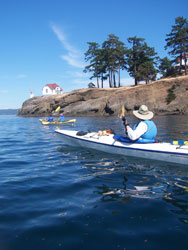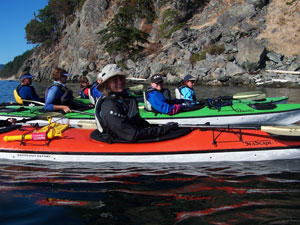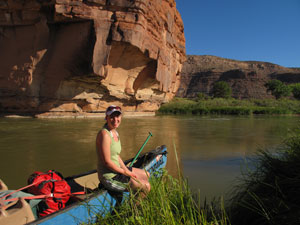
- Read 18 reviews of Centennial Canoe Outfitters - Day Tour
First Timers FAQ
Thinking about a sea kayak trip (go here)
Want to send us a message (go here)
Ready to talk to us - call (720) 283-0553
Thinking about taking a canoe trip? Here are a few frequently asked questions:
Will there be a safety talk?
Yes, your guides will give a 30-point safety talk the morning of your trip.
Will there be paddling instruction?
Yes, your guides will show you basic paddling techniques the morning of your trip.
What if I’ve never paddled a canoe before?
Many of our rivers are ideal for first-time paddlers. Be sure to address this when signing up for a trip. We want you to have fun and be excited…not scared.
What if I’ve never camped before?
That’s okay, your guides are glad to help put up your tent.
What if it rains?
Rain showers are usually brief in the desert and frankly quite refreshing. We recommend good rain gear that covers your head, upper torso and legs.
Are all my meals included?
Yes, starting with breakfast the first morning of your trip through lunch on the last day of the trip.
Can you accommodate vegetarians, gluten and lactose intolerant people?
Yes, just let us know upon signing up for your trip.
Who does all the cooking?
Your guides and they do the dishes afterwards! The kitchen is a fun place to be so you might want to help.
What if I’m on a highly restricted diet?
We’re happy to email you the entire trip menu for your review. We think you’ll find it quite versatile. However, you’re always welcome to bring any special food you’d like and the guides will help you cook it.
May I bring my own beverages?
We invite you to bring a medium sized cooler (in the 28 qt. range) with any drinks you’d like. If adult beverages are consumed, we ask that you drink responsibly. We serve complementary wine at dinner.
Will there be plenty of water on the trip?
Yes, we’ll bring 5 gallon jugs of fresh water.
What gear does Centennial provide?
We’ll provide the canoes, paddles, life jackets, water, food, safety equipment, stoves and guides.
What are the big items I need to bring?
Tent, sleeping bag, mattress pad and camp chair.
How does my gear get down the river?
All personal and community gear gets tied into the canoes. Each person will receive a “Dry Bag,” which is a waterproof bag about the size of a military duffle bag. You can fit you sleeping bag, mattress pad and tent into this bag. You should also have space to include personal clothing.
If I go on the trip alone, will I have someone to paddle with?
Going alone or “solo” is no problem and happens all the time. The guides will pair you with another person or you might paddle with one of the guides.
How many hours a day will we paddle?
You’ll usually spend about 5 hours a day paddling. There will also be a one-hour break for lunch. Count on covering about 14-miles per day.
What is the weather like?
You’ll be in a desert environment and the day to night temperature swings are about 30 degrees. Daytime: June, 80’s, July 90’s, August 80’s, September 80’s.
Are the guides trained in First Aid?
Yes, and many of our guides are Wilderness First Responders, which is advanced First Aid.
Where will we pitch our tents?
On the rivers edge.
Are their bathroom facilities?
No, you’ll be in the remote backcountry and we’re required to pack out all human waste. Your trip will be equipped with a portable toilet housed in a privacy tent.
Will there be cell phone reception?
Yes & no. Cell reception continues to get better in remote areas. You can usually get cell reception if you move around a little bit or get to a high point near the river.
What happens to my car while I’m on the river?
Your guides will coordinate a caravan to move cars to the take-out so it will be waiting for you at the conclusion of your trip. Or, you’ll be shuttled in a Centennial passenger van. Car shuttling all depends on the river you choose.
How do I sign up for a trip?
On our website, check by mail or by calling our office. We accept Visa, Mastercard and Discover.
How old does a child need to be?
Kids must be 6 years old. Our advanced rivers require kids to be 13. Our children’s prices are for kids 6-12 years old.
How big are the canoes?
We use 16’9” long canoes that are designed for two adults and to carry lots of gear.
Do they tip over very easily?
Any kind of boat can capsize and some more easily than others. As canoes go, ours are very stable because the bottom is very flat. They’re designed for long-distance touring.
What brand canoes do you use?
We only use Old Town canoes made with 3-layer Royalex. The middle layer is an air-filled foam material that makes the canoe unsinkable.
 Thinking about taking a sea kayak trip? Here are a few frequently asked questions:
Thinking about taking a sea kayak trip? Here are a few frequently asked questions:
When is the best time of year for paddling in the San Juans?
It depends to some extent on what you're looking for. Late June, July and August is considered the best time for seeing orca whales. The islands tend to be less crowded in late May - June, but offer greater probabilities of getting variable weather. July and August generally offer the best weather in terms of less precipitation. The downside is that there is more boat traffic and campsites can be more crowded. My personal favorite is the month of September. Paddling after Labor Day offers fewer people, the weather is usually still good and you generally have your pick of campsites.
When is the best time to see whales?
The southern resident pods of orca whales currently number over 86 individually identified whales in three separate pods. They are generally found in the San Juan and Canadian Gulf Islands between May and October when salmon, their primary prey, come from the ocean to spawn in either the Fraser River or the rivers of the Puget Sound. Late June, July and August are the best months for seeing these magnificent creatures. Last year the Orcas were making semi-regular appearances through mid-October. Ya’ just never know.....
I have never kayaked before. Is that going to be a problem?
No. I would say that probably 70% of our first time customers have never kayaked before. We have been taking out beginners on our San Juan trips for the last 25 years. We are able to accommodate beginners because we use double kayaks, which are wider and more stable than single kayaks. We also have a very thorough on-land orientation teaching the basics of paddling, steering and fitting the boat. We won't get on the water until everybody feels comfortable about paddling. Another important consideration is that our groups don't venture very far from the coast. We don't really need to, as the wildlife tends to concentrate along the coast where we run operate our tours.
Why choose your company over others that are found on the island?
With 25 years in the industry we are one of the oldest and most respected companies around. We hire guides that are older and more mature and can hold an intelligent conversation around a campfire. (Average age is 28) Our camp cuisine is, simply, some of the best with an emphasis on regional NW cuisine coupled with Dutch oven cookery. Our tours are “all – inclusive” meaning we supply everything you’ll need and, unlike some outfitters, don’t skimp on small but ‘niggly’ items such as dry bags and lunches.
How do I get up to the islands from Seattle?
You have a number of different travel options. The majority of our guests take a shuttle van that leaves right from Sea Tac airport 7-9 times a day and transports you to the Anacortes ferry terminal, which is about a two and a half drive. At the terminal it is simply a matter of buying a round trip walk on ticket to Friday Harbor, which will cost around $13.00.
The other method many of our guests get up to the island is to fly. There are commercial flights leaving from Sea Tac airport as well as seaplane flights. When you sign up for a trip we’ll e-mail you all the travel details you’ll need to arrange your transportation needs to San Juan Island.
What other wildlife do we have opportunities of seeing?
It may be easier to list what you won't see. Some of the more common sightings include minke whales, dall and harbor porpoises, harbor seals, and river otters. In terms of birds, the San Juans are host to the second largest breeding population of bald eagles in the lower 48 states. Other birds include terns, gulls, ducks, various alcids, and a host of others. In addition last summer we were lucky enough to have sightings of gray whales, a young humpback whale, pilot whales, elephant seals and California sea lions.
I've never kayaked before. Do I need any previous kayaking experience?
No experience is necessary! Beginners are welcome on all our Eagles & Orcas tours. Generally, most of our guests have never kayaked before. We use stable double kayaks and employ seasoned guides who will give you pointers and assist you with your paddling skills throughout the duration of the tour.
How far do we kayak every day?
It will vary, but figure on an average of 7-10 miles per day with 12 miles the maximum we would paddle in one day. Our tours are geared for novices, so we're not out there to make "mega-miles." We also include a layover day on the third day of our 5-day tour where our guests have the option of going for a hike, an evening paddle, or simply lounging around in camp.
I'm single.... How does that work if I come by myself?
Our groups typically include a mixture of both single guests and couples. We'll pair you up with another single guest or if there is an odd number of people on the trip you may paddle with one of our guides.
10. "I pretty much eat vegetarian...will that be a problem?
Not at all. No red meats or chicken are served on any of our trips. We do have one entree where smoked salmon is utilized and one lunch where canned tuna is eaten. In both cases other food is readily available. If you are a total vegan or gluten free, let us know in advance and we should be able to accommodate your needs. If you are an especially picky eater or have extreme food allergies you are welcome to bring some of your own foods to supplement ours.
What are the camping facilities like?
We camp on various islands in the San Juan archipelago that are accessible only by boat. Our campsites are usually beautiful waterfront sites. The campsites are administered by the Washington State Parks Department. All the sites have picnic tables, fire pits, potable water and outhouses.
Are showers available?
Unfortunately, there are no showers available unless you have chosen our three day kayaking and hiking tour where we stay at local Bed and Breakfasts. On the positive side, if you've never kayaked before you'll be pleasantly surprised that you do not get as dirty and sweaty as you would backpacking. There are public showers located in Friday Harbor at the end of the trip.




